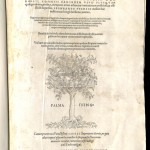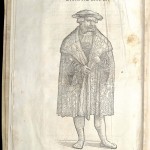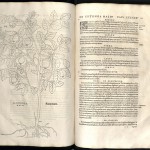Tags
Albrecht Meyer, botany, Columbian Encounter, De Historia Stirpium, Erfurt University, Fuchsia, German, Greek, Heinrich Fullmaurer, herbals, Ingolstadt, Latin, Leonhart Fuchs, maize, marigold, medicine, Mexico, plague, plants, potato, pumpkin, Renaissance, tobacco, Veit Rudof Speckle, William Morris, woodcuts
- Fuchs, 1542, Title page
- Fuchs, 1542, Portrait
- Fuchs, 1542
De Historia Stirpivm Commentarii Insignes…
Leonhart Fuchs (1501 – 1566)
Basileae: In officina Isingriniana, 1542
QK41 F7 1542
During the European Renaissance, medical treatments were based on botany, but the herbals and other books available to practitioners often inaccurately identified plants. This herbal, The History of Plants, established a new standard of scientific observation and accurate illustration. Leonhart Fuchs compiled his text from various classical sources but added his own field observations.
The remarkably detailed woodcuts, drawn by Heinrich Fullmaurer and Albrecht Meyer and cut by Veit Rudolf Speckle represent the first published illustrations of American plants, including the pumpkin, the marigold, maize, potato, and tobacco – all native to Mexico and introduced into Europe as a consequence of the Columbian Encounter. The plants were identified in Latin, Greek, and German.
Leonhart Fuchs was a child genius, matriculating at Erfurt University at the age of twelve. He went on to take a degree in medicine at Ingolstadt. His medical work during an outbreak of plague in 1529 was outstanding and contributed to an already growing reputation. In his De Historia Stirpium he gave full recognition to his artists by praising them in his preface and publishing their portraits. The artists achieved an extraordinary beauty of line. Their renderings demonstrate the Renaissance shift to the accurate observation and drawing of plants from life.
Fuchs would be immortalized in the lovely genus Fuchsia. English artist and designer William Morris owned a copy of Fuchs’s book and clearly took inspiration from it for some of his own designs.




You must be logged in to post a comment.